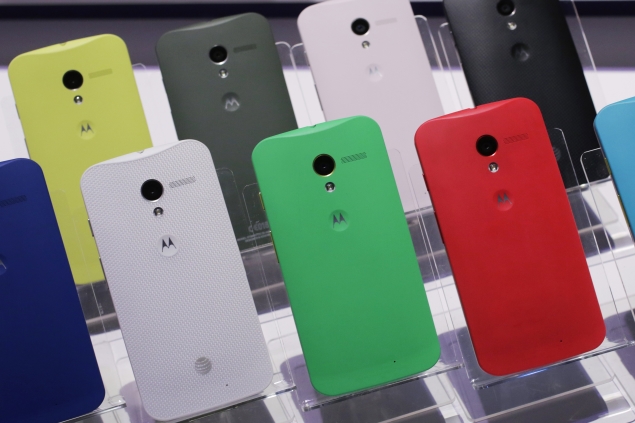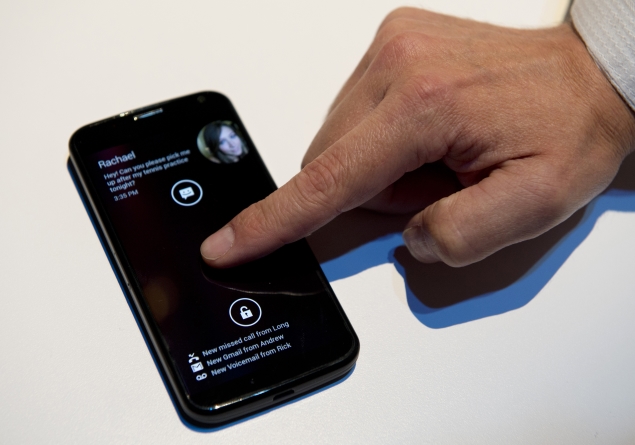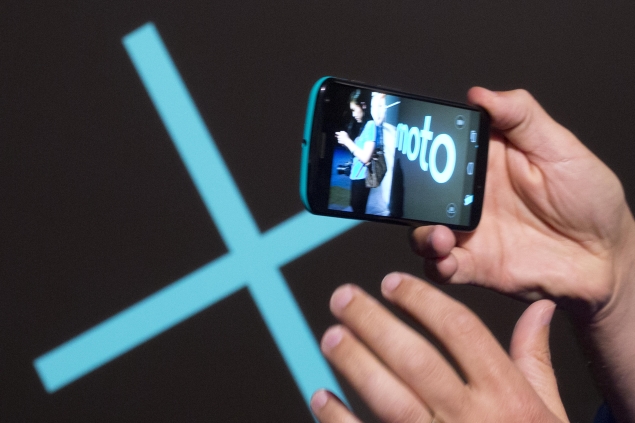Yes, there's plenty the Moto X offers in terms of software, including the ability to get directions, seek trivia answers or set the alarm without ever touching the phone. There's good hardware, too, including a body that's nearly as slim as the iPhone 5, but with the larger, 4.7-inch screen that is comparable to those found in rival Android phones.
You can buy the phone the traditional way, in black or white. Walk into a store, pay about $200, sign a two-year service agreement (or installment plan with T-Mobile), and off you go with a brand new phone.
Motorola is moving away from traditional black and white. You're still limited to black or white as your front color, but you can choose any combination of 18 back cover colors and seven "accent" colors, which highlight the power button, volume control and the rim of the camera lens. There's more coming: Motorola is testing back covers made of wood, for instance, and it plans to let people vote on Facebook on future patterns, colors and designs.

With the exception of $50 more for a phone with 32 gigabytes of storage rather than 16 gigabytes, there's no cost for the customization. They will be available at about the same time the standard white and black phones come out in late August or early September. Wood back covers aren't expected until later in the year, however.
In many ways, it's similar to the way desktops and laptops have been sold. You can go to Dell's or Apple's website and order any number of configurations. The difference is those configurations typically have to do with the amount of storage, the speed of the processor, the size of the screen and the software that comes with the machine. With Moto X, you're getting the same storage choices that other phones offer, but all the other options are cosmetic.

Meanwhile, the Moto X advances hands-free phone use. Although hands-free options are available elsewhere to make a call or send a text, Moto X opens the
door to the entire Web. It relies on Google Now, the virtual assistant that retrieves information when you speak into the phone. Normally, you press something to activate Google Now. That's how Siri works on iPhones as well. With Moto X, you simply say, "OK, Google Now."
That command is specific to your voice. I asked three colleagues to speak "OK, Google Now" into a phone I trained by repeating the phrase three times. The phone ignored my colleagues, but responded to me instantly once I spoke from the same distance. Sorry, pranksters: You won't be able use this feature to set 3 a.m. alarms on your friend's Moto X.
I was able to get the phone to recognize my command from about 10 feet away, as well as close by with an episode of "The Walking Dead" playing at full blast on a laptop inches away. But under those conditions, the service was more prone to make mistakes. For instance, the phone misheard a request for directions to Boston as "directions to fall."
Even in a quiet room, Google Now made a lot of mistakes responding to requests to call specific people. When I asked Google Now to "call Bob," it offered me "Emily," ''Dave" and "Super" - for the superintendent of my apartment building, who's not named Bob.
I can see this feature being useful to motorists, but it's imperfect. And if you protect your phone with a PIN code, you'll need to type it in to unlock the phone, except to make a call. Motorola says it tried voice recognition for passwords, but couldn't get it to work properly.
There are two things that will work without entering your PIN: You can get a peek at text messages and other notifications by pressing the center of the screen for a second. If you want to respond or see more, then you'll need the PIN. You can also access your camera by twisting the phone like opening a doorknob. You can browse through shots you have just taken, but you'll need the PIN for older ones.
Speaking of the camera, Motorola did a good job of keeping it simple. With Samsung's Galaxy S4 and HTC One, I've often hit the wrong buttons for gimmicky features I don't want. With the Moto X, you have to swipe the screen from the left to access the settings. That way, the buttons aren't there to hit accidently. To access your gallery of photos, you swipe from the right. Again, you won't be getting old images accidently and miss the chance to snap a new one.


No comments:
Post a Comment